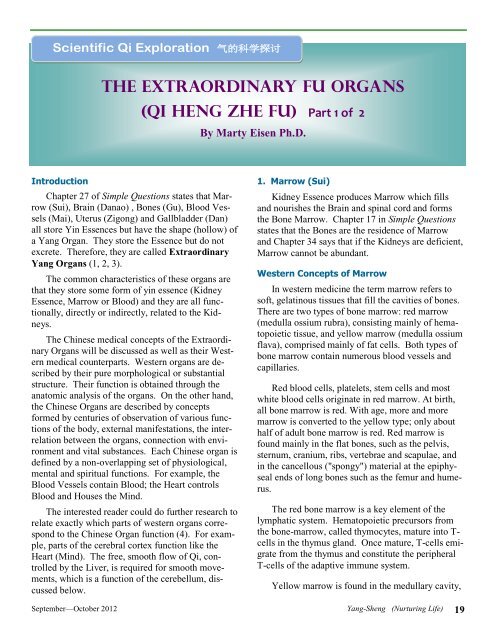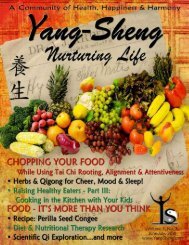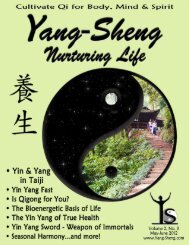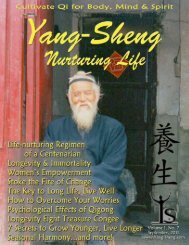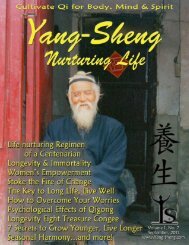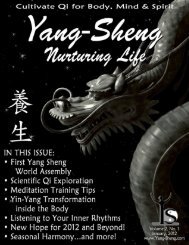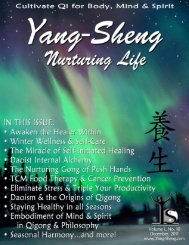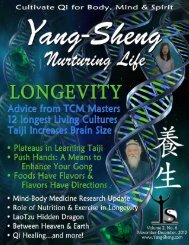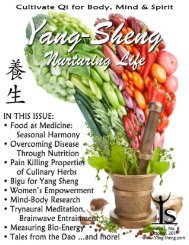Download - Yang-Sheng
Download - Yang-Sheng
Download - Yang-Sheng
Create successful ePaper yourself
Turn your PDF publications into a flip-book with our unique Google optimized e-Paper software.
Scientific Qi Exploration 气 的 科 学 探 讨<br />
The Extraordinary Fu Organs<br />
(Qi Heng Zhe Fu) Part 1 of 2<br />
By Marty Eisen Ph.D.<br />
Introduction<br />
Chapter 27 of Simple Questions states that Marrow<br />
(Sui), Brain (Danao) , Bones (Gu), Blood Vessels<br />
(Mai), Uterus (Zigong) and Gallbladder (Dan)<br />
all store Yin Essences but have the shape (hollow) of<br />
a <strong>Yang</strong> Organ. They store the Essence but do not<br />
excrete. Therefore, they are called Extraordinary<br />
<strong>Yang</strong> Organs (1, 2, 3).<br />
The common characteristics of these organs are<br />
that they store some form of yin essence (Kidney<br />
Essence, Marrow or Blood) and they are all functionally,<br />
directly or indirectly, related to the Kidneys.<br />
The Chinese medical concepts of the Extraordinary<br />
Organs will be discussed as well as their Western<br />
medical counterparts. Western organs are described<br />
by their pure morphological or substantial<br />
structure. Their function is obtained through the<br />
anatomic analysis of the organs. On the other hand,<br />
the Chinese Organs are described by concepts<br />
formed by centuries of observation of various functions<br />
of the body, external manifestations, the interrelation<br />
between the organs, connection with environment<br />
and vital substances. Each Chinese organ is<br />
defined by a non-overlapping set of physiological,<br />
mental and spiritual functions. For example, the<br />
Blood Vessels contain Blood; the Heart controls<br />
Blood and Houses the Mind.<br />
The interested reader could do further research to<br />
relate exactly which parts of western organs correspond<br />
to the Chinese Organ function (4). For example,<br />
parts of the cerebral cortex function like the<br />
Heart (Mind). The free, smooth flow of Qi, controlled<br />
by the Liver, is required for smooth movements,<br />
which is a function of the cerebellum, discussed<br />
below.<br />
1. Marrow (Sui)<br />
Kidney Essence produces Marrow which fills<br />
and nourishes the Brain and spinal cord and forms<br />
the Bone Marrow. Chapter 17 in Simple Questions<br />
states that the Bones are the residence of Marrow<br />
and Chapter 34 says that if the Kidneys are deficient,<br />
Marrow cannot be abundant.<br />
Western Concepts of Marrow<br />
In western medicine the term marrow refers to<br />
soft, gelatinous tissues that fill the cavities of bones.<br />
There are two types of bone marrow: red marrow<br />
(medulla ossium rubra), consisting mainly of hematopoietic<br />
tissue, and yellow marrow (medulla ossium<br />
flava), comprised mainly of fat cells. Both types of<br />
bone marrow contain numerous blood vessels and<br />
capillaries.<br />
Red blood cells, platelets, stem cells and most<br />
white blood cells originate in red marrow. At birth,<br />
all bone marrow is red. With age, more and more<br />
marrow is converted to the yellow type; only about<br />
half of adult bone marrow is red. Red marrow is<br />
found mainly in the flat bones, such as the pelvis,<br />
sternum, cranium, ribs, vertebrae and scapulae, and<br />
in the cancellous ("spongy") material at the epiphyseal<br />
ends of long bones such as the femur and humerus.<br />
The red bone marrow is a key element of the<br />
lymphatic system. Hematopoietic precursors from<br />
the bone-marrow, called thymocytes, mature into T-<br />
cells in the thymus gland. Once mature, T-cells emigrate<br />
from the thymus and constitute the peripheral<br />
T-cells of the adaptive immune system.<br />
Yellow marrow is found in the medullary cavity,<br />
September—October 2012 <strong>Yang</strong>-<strong>Sheng</strong> (Nurturing Life) 19


